| Article ID | Journal | Published Year | Pages | File Type |
|---|---|---|---|---|
| 1084955 | Midwifery | 2013 | 7 Pages |
Objectivethis study was to evaluate the impact of a quality improvement initiative in Malawi on reproductive health service quality and related outcomes.Design(1) post-only quasi-experimental design comparing observed service quality at intervention and comparison health facilities, and (2) a time-series analysis of service statistics.Settingsixteen of Malawi's 23 district hospitals, half of which had implemented the Performance and Quality Improvement (PQI) intervention for reproductive health at the time of the study.Participantsa total of 98 reproductive health-care providers (mostly nurse–midwives) and 139 patients seeking family planning (FP), antenatal care (ANC), labour and delivery (L&D), or postnatal care (PNC) services.Interventionhealth facility teams implemented a performance and quality improvement (PQI) intervention over a 3-year period. Following an external observational assessment of service quality at baseline, facility teams analysed performance gaps, designed and implemented interventions to address weaknesses, and conducted quarterly internal assessments to assess progress. Facilities qualified for national recognition by complying with at least 80% of reproductive health clinical standards during an external verification assessment.Measurementskey measures include facility readiness to provide quality care, observed health-care provider adherence to clinical performance standards during service delivery, and trends in service utilisation.Findingsintervention facilities were more likely than comparison facilities to have the needed infrastructure, equipment, supplies, and systems in place to offer reproductive health services. Observed quality of care was significantly higher at intervention than comparison facilities for PNC and FP. Compared with other providers, those at intervention facilities scored significantly higher on client assessment and diagnosis in three service areas, on clinical management and procedures in two service areas, and on counselling in one service area. Service statistics suggest that the PQI intervention increased the number of Caesarean sections, but showed no impact on other indicators of service utilisation and skilled care.Conclusionsthe PQI intervention showed a positive impact on the quality of reproductive health services. The effects of the intervention on service utilisation had likely not yet been fully realized, since none of the facilities had achieved national recognition before the evaluation. Staff turnover needs to be reduced to maximise the effectiveness of the intervention.Implications for practicethe PQI intervention evaluated here offers an effective way to improve the quality of health services in low-resource settings and should continue to be scaled up in Malawi.
